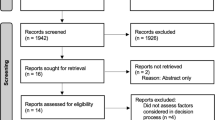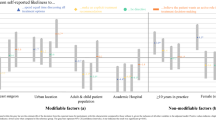Abstract
Introduction
Leading cancer hospitals have increasingly shared their ‘brand’ with smaller hospitals through affiliations. Because each brand evokes a distinct reputation for the care provided, ‘brand-sharing’ has the potential to impact the public’s ability to differentiate the safety and quality within hospital networks. The general public was surveyed to determine the perceived similarities and differences in the safety and quality of complex cancer surgery performed at top cancer hospitals and their smaller affiliate hospitals.
Methods
A national, web-based KnowledgePanel (GfK) survey of American adults was conducted. Respondents were asked about their beliefs regarding the quality and safety of complex cancer surgery at a large, top-ranked cancer hospital and a smaller, local hospital, both in the presence and absence of an affiliation between the hospitals.
Results
A total of 1010 surveys were completed (58.1% response rate). Overall, 85% of respondents felt ‘motivated’ to travel an hour for complex surgery at a larger hospital specializing in cancer, over a smaller local hospital. However, if the smaller hospital was affiliated with a top-ranked cancer hospital, 31% of the motivated respondents changed their preference to the smaller hospital. When asked to compare leading cancer hospitals and their smaller affiliates, 47% of respondents felt that surgical safety, 66% felt guideline compliance, and 53% felt cure rates would be the same at both hospitals.
Conclusions
Approximately half of surveyed Americans did not distinguish the quality and safety of surgical care at top-ranked cancer hospitals from their smaller affiliates, potentially decreasing their motivation to travel to top centers for complex surgical care.

Similar content being viewed by others
References
Hillner BE, Smith TJ, Desch CE. Hospital and physician volume or specialization and outcomes in cancer treatment: importance in quality of cancer care. J Clin Oncol. 2000;18(11):2327–2340.
Birkmeyer JD, Siewers AE, Finlayson EVA, et al. Hospital volume and surgical mortality in the United States. N Engl J Med. 2002;346(15):1128–1137.
Reames BN, Ghaferi AA, Birkmeyer JD, Dimick JB. Hospital volume and operative mortality in the modern era. Ann Surg. 2014;260(2):244–251.
Ejaz A, Spolverato G, Bridges JF, Amini N, Kim Y, Pawlik TM. Choosing a cancer surgeon: analyzing factors in patient decision making using a best-worst scaling methodology. Ann Surg Oncol. 2014;21(12):3732–3738.
Pope DG. Reacting to rankings: evidence from “America’s Best Hospitals”. J Health Econ. 2009;28(6):1154–1165.
Dafny L. Hospital industry consolidation: still more to come? N Engl J Med. 2014;370(3):198–199.
Birkmeyer JD, Siewers AE, Marth NJ, Goodman DC. Regionalization of high-risk surgery and implications for patient travel times. JAMA. 2003;290(20):2703–2708.
Hanauer DA, Zheng K, Singer DC, Gebremariam A, Davis MM. Public awareness, perception, and use of online physician rating sites. JAMA. 2014;311(7):734–735.
Tomlinson T, De Vries R, Ryan K, Kim HM, Lehpamer N, Kim SY. Moral concerns and the willingness to donate to a research biobank. JAMA. 2015;313(4):417–419.
Chiong W, Kim AS, Huang IA, Farahany NA, Josephson SA. Testing the presumption of consent to emergency treatment for acute ischemic stroke. JAMA. 2014;311(16):1689–1691.
Grande D, Mitra N, Shah A, Wan F, Asch DA. Public preferences about secondary uses of electronic health information. JAMA Intern Med. 2013;173(19):1798–1806.
Rhodes DJ, Radecki Breitkopf C, Ziegenfuss JY, Jenkins SM, Vachon CM. Awareness of breast density and its impact on breast cancer detection and risk. J Clin Oncol. 2015;33(10):1143–1150.
GfK. Knowledge panel design summary. Palo Alto, CA: GfK; 2013.
Chiu AS, Arnold BN, Hoag JR, et al. Quality versus quantity: the potential impact of public reporting of hospital safety for complex cancer surgery. Ann Surg. Epub 24 Apr 2018. https://doi.org/10.1097/sla.0000000000002762.
Cutler DM, Scott Morton F. Hospitals, market share, and consolidation. JAMA. 2013;310(18):1964–1970.
Urbach DR. Pledging to eliminate low-volume surgery. N Engl J Med. 2015;373(15):1388–1390.
Birkmeyer JD, Dimick JB. Potential benefits of the new leapfrog standards: effect of process and outcomes measures. Surgery. 2004;135(6):569–575.
Chiu A, Resio B, Hoag J, et al. US public perceptions about cancer care provided by smaller hospitals associated with large hospitals recognized for specializing in cancer care. JAMA Oncol. 2018;4(7):1008–1009. https://doi.org/10.1001/jamaoncol.2018.1400.
Tsai TC, Jha AK. Hospital consolidation, competition, and quality: is bigger necessarily better? JAMA. 2014;312(1):29–30.
Dranove D, Lindrooth R. Hospital consolidation and costs: another look at the evidence. J Health Econ. 2003;22(6):983–997.
Tsai TC, Joynt KE, Orav EJ, Gawande AA, Jha AK. Variation in surgical-readmission rates and quality of hospital care. N Engl J Med. 2013;369(12):1134–1142.
Funk LM, Gawande AA, Semel ME, et al. Esophagectomy outcomes at low-volume hospitals: the association between systems characteristics and mortality. Ann Surg. 2011;253(5):912–917.
Sheetz KH, Ryan AM, Ibrahim AM, Dimick JB. Association of hospital network participation with surgical outcomes and medicare expenditures. Ann Surg. Epub 18 Apr 2018. https://doi.org/10.1097/sla.0000000000002791.
Emmert M, Schlesinger M. Patients’ awareness, usage and impact of hospital report cards in the US. Patient. 2017;10(6):729–738.
Mulvey GK, Wang Y, Lin Z, et al. Mortality and readmission for patients with heart failure among U.S. News & World Report’s top heart hospitals. Circ Cardiovasc Qual Outcomes. 2009;2(6):558–565.
Wang OJ, Wang Y, Lichtman JH, Bradley EH, Normand SL, Krumholz HM. “America’s Best Hospitals” in the treatment of acute myocardial infarction. Arch Intern Med. 2007;167(13):1345–1351.
Escarce JJ, Kapur K. Do patients bypass rural hospitals? Determinants of inpatient hospital choice in rural California. J Health Care Poor Underserved. 2009;20(3):625–644.
Buczko W. Bypassing of local hospitals by rural Medicare beneficiaries. J Rural Health. 1994;10(4):237–246.
Tai W-TC, Porell FW, Adams EK. Hospital choice of rural medicare beneficiaries: patient, hospital attributes, and the patient–physician relationship. Health Serv Res. 2004;39(6 Pt 1):1903–1922.
Roh C-Y, Moon MJ. Nearby, but not wanted? The bypassing of rural hospitals and policy implications for rural health care systems. Policy Stud J. 2005;33(3):377–394.
Finlayson SR, Birkmeyer JD, Tosteson AN, Nease RF, Jr. Patient preferences for location of care: implications for regionalization. Med Care. 1999;37(2):204–209.
Author information
Authors and Affiliations
Corresponding author
Electronic supplementary material
Below is the link to the electronic supplementary material.
Rights and permissions
About this article
Cite this article
Chiu, A.S., Resio, B., Hoag, J.R. et al. Why Travel for Complex Cancer Surgery? Americans React to ‘Brand-Sharing’ Between Specialty Cancer Hospitals and Their Affiliates. Ann Surg Oncol 26, 732–738 (2019). https://doi.org/10.1245/s10434-018-6868-9
Received:
Published:
Issue Date:
DOI: https://doi.org/10.1245/s10434-018-6868-9




